Strawberry
The garden strawberry (or simply strawberry; Fragaria × ananassa)[1] is a widely grown hybrid species of the genus Fragaria, collectively known as the strawberries, which are cultivated worldwide for their fruit. The fruit is widely appreciated for its characteristic aroma, bright red color, juicy texture, and sweetness. It is consumed in large quantities, either fresh or in such prepared foods as jam, juice, pies, ice cream, milkshakes, and chocolates. Artificial strawberry flavorings and aromas are also widely used in products such as candy, soap, lip gloss, perfume, and many others.
| Strawberry Fragaria × ananassa | |
|---|---|
_single.jpg.webp) | |
| Strawberry fruit | |
| Scientific classification | |
| Kingdom: | Plantae |
| Clade: | Tracheophytes |
| Clade: | Angiosperms |
| Clade: | Eudicots |
| Clade: | Rosids |
| Order: | Rosales |
| Family: | Rosaceae |
| Genus: | Fragaria |
| Species: | F. × ananassa |
| Binomial name | |
| Fragaria × ananassa | |
The garden strawberry was first bred in Brittany, France, in the 1750s via a cross of Fragaria virginiana from eastern North America and Fragaria chiloensis, which was brought from Chile by Amédée-François Frézier in 1714.[2] Cultivars of Fragaria × ananassa have replaced, in commercial production, the woodland strawberry (Fragaria vesca), which was the first strawberry species cultivated in the early 17th century.[3]
The strawberry is not, from a botanical point of view, a berry. Technically, it is an aggregate accessory fruit, meaning that the fleshy part is derived not from the plant's ovaries but from the receptacle that holds the ovaries.[4] Each apparent "seed" (achene) on the outside of the fruit is actually one of the ovaries of the flower, with a seed inside it.[4]
In 2017, world production of strawberries was 9.2 million tonnes. China was the top producer, with 40% of total production.
History
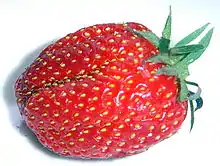
The first garden strawberry was grown in Brittany, France, during the late 18th century.[3] Prior to this, wild strawberries and cultivated selections from wild strawberry species were the common source of the fruit.
The strawberry fruit was mentioned in ancient Roman literature in reference to its medicinal use. The French began taking the strawberry from the forest to their gardens for harvest in the 14th century. Charles V, France's king from 1364 to 1380, had 1,200 strawberry plants in his royal garden. In the early 15th century western European monks were using the wild strawberry in their illuminated manuscripts. The strawberry is found in Italian, Flemish, and German art, and in English miniatures. The entire strawberry plant was used to treat depressive illnesses.
By the 16th century, references of cultivation of the strawberry became more common. People began using it for its supposed medicinal properties and botanists began naming the different species. In England the demand for regular strawberry farming had increased by the mid-16th century.
The combination of strawberries and cream was created by Thomas Wolsey in the court of King Henry VIII.[5] Instructions for growing and harvesting strawberries showed up in writing in 1578. By the end of the 16th century three European species had been cited: F. vesca, F. moschata, and F. viridis. The garden strawberry was transplanted from the forests and then the plants would be propagated asexually by cutting off the runners.
Two subspecies of F. vesca were identified: F. sylvestris alba and F. sylvestris semperflorens. The introduction of F. virginiana from Eastern North America to Europe in the 17th century is an important part of history because it is one of the two species that give rise to the modern strawberry. The new species gradually spread through the continent and did not become completely appreciated until the end of the 18th century. A French excursion journeyed to Chile in 1712, which led to the introduction of a strawberry plant with female flowers that resulted in the common strawberry we have today.
The Mapuche and Huilliche Indians of Chile cultivated the female strawberry species until 1551, when the Spanish came to conquer the land. In 1765, a European explorer recorded the cultivation of F. chiloensis, the Chilean strawberry. At first introduction to Europe, the plants grew vigorously but produced no fruit. French gardeners in Brest and Cherbourg around the mid 18th century first noticed that when F. moschata and F. virginiana were planted in between rows of F. chiloensis, the Chilean strawberry would bear abundant and unusually large fruits. Soon after, Antoine Nicolas Duchesne began to study the breeding of strawberries and made several discoveries crucial to the science of plant breeding, such as the sexual reproduction of strawberry which he published in 1766. Duchesne discovered that the female F. chiloensis plants could only be pollinated by male F. moschata or F. virginiana plants.[6] This is when the Europeans became aware that plants had the ability to produce male-only or female-only flowers.
Duchesne determined F. ananassa to be a hybrid of F. chiloensis and F. virginiana. F. ananassa, which produces large fruits, is so-named because it resembles the pineapple in smell, taste and berry shape. In England, many varieties of F. ananassa were produced, and they form the basis of modern varieties of strawberries currently cultivated and consumed. Further breeding were also conducted in Europe and America to improve the hardiness, disease resistance, size, and taste of strawberries.[6]
Cultivation
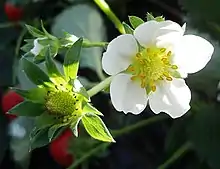
_close-up.jpg.webp)
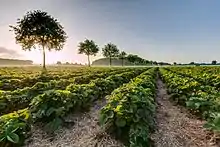
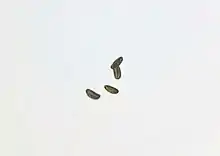
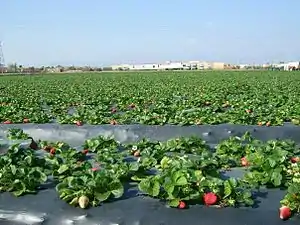
Strawberry cultivars vary widely in size, color, flavor, shape, degree of fertility, season of ripening, liability to disease and constitution of plant.[7] On average, a strawberry has about 200 seeds on its external membrane.[8] Some vary in foliage, and some vary materially in the relative development of their sexual organs. In most cases, the flowers appear hermaphroditic in structure, but function as either male or female.[9] For purposes of commercial production, plants are propagated from runners and, in general, distributed as either bare root plants or plugs. Cultivation follows one of two general models—annual plasticulture,[10] or a perennial system of matted rows or mounds.[11] Greenhouses produce a small amount of strawberries during the off season.[12]
The bulk of modern commercial production uses the plasticulture system. In this method, raised beds are formed each year, fumigated, and covered with plastic to prevent weed growth and erosion. Plants, usually obtained from northern nurseries, are planted through holes punched in this covering, and irrigation tubing is run underneath. Runners are removed from the plants as they appear, in order to encourage the plants to put most of their energy into fruit development. At the end of the harvest season, the plastic is removed and the plants are plowed into the ground.[10][13] Because strawberry plants more than a year or two old begin to decline in productivity and fruit quality, this system of replacing the plants each year allows for improved yields and denser plantings.[10][13] However, because it requires a longer growing season to allow for establishment of the plants each year, and because of the increased costs in terms of forming and covering the mounds and purchasing plants each year, it is not always practical in all areas.[13]
The other major method, which uses the same plants from year to year growing in rows or on mounds, is most common in colder climates.[10][11] It has lower investment costs, and lower overall maintenance requirements.[11] Yields are typically lower than in plasticulture.[11]
Another method uses a compost sock. Plants grown in compost socks have been shown to produce significantly higher oxygen radical absorbance capacity (ORAC), flavonoids, anthocyanins, fructose, glucose, sucrose, malic acid, and citric acid than fruit produced in the black plastic mulch or matted row systems.[14] Similar results in an earlier study conducted by USDA confirms how compost plays a role in the bioactive qualities of two strawberry cultivars.[15]
Strawberries are often grouped according to their flowering habit.[7][16] Traditionally, this has consisted of a division between "June-bearing" strawberries, which bear their fruit in the early summer and "ever-bearing" strawberries, which often bear several crops of fruit throughout the season.[16] One plant throughout a season may produce 50 to 60 times or roughly once every three days.[17]
Research published in 2001 showed that strawberries actually occur in three basic flowering habits: short-day, long-day, and day-neutral. These refer to the day-length sensitivity of the plant and the type of photoperiod that induces flower formation. Day-neutral cultivars produce flowers regardless of the photoperiod.[18]
Strawberries may also be propagated by seed, though this is primarily a hobby activity, and is not widely practiced commercially. A few seed-propagated cultivars have been developed for home use, and research into growing from seed commercially is ongoing.[19] Seeds (achenes) are acquired either via commercial seed suppliers, or by collecting and saving them from the fruit.
Strawberries can also be grown indoors in strawberry pots.[20] Although the plant may not naturally grow indoors in the winter, use of LED lighting in combination of blue and red light can allow the plant to grow during the winter.[21] Additionally, in certain areas like the state of Florida, winter is the natural growing season where harvesting starts in mid-November.[17]
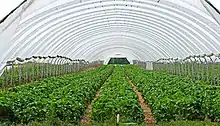
The Kashubian strawberry (Truskawka kaszubska or Kaszëbskô malëna)[22] is the first Polish fruit to be given commercial protection under EU law. They are produced in Kartuzy, Kościerzyna and Bytów counties and in the municipalities of Przywidz, Wejherowo, Luzino, Szemud, Linia, Łęczyce and Cewice in Kashubia. Only the following varieties may be sold as kaszëbskô malëna: Senga Sengana, Elsanta, Honeoye that have been graded as Extra or Class I.
Manuring and harvesting
Most strawberry plants are now fed with artificial fertilizers, both before and after harvesting, and often before planting in plasticulture.[23]
To maintain top quality, berries are harvested at least every other day. The berries are picked with the caps still attached and with at least half an inch of stem left. Strawberries need to remain on the plant to fully ripen because they do not continue to ripen after being picked. Rotted and overripe berries are removed to minimize insect and disease problems. The berries do not get washed until just before consumption.[24]
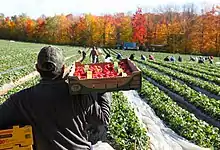
Soil test information and plant analysis results are used to determine fertility practices. Nitrogen fertilizer is needed at the beginning of every planting year. There are normally adequate levels of phosphorus and potash when fields have been fertilized for top yields. In order to provide more organic matter, a cover crop of wheat or rye is planted in the winter before planting the strawberries. Strawberries prefer a pH from 5.5 to 6.5, so lime is usually not applied.[25]
The harvesting and cleaning process has not changed substantially over time. The delicate strawberries are still harvested by hand.[26] Grading and packing often occurs in the field, rather than in a processing facility.[26] In large operations, strawberries are cleaned by means of water streams and shaking conveyor belts.
Pests
Around 200 species of pests are known to attack strawberries both directly and indirectly.[27] These pests include slugs, moths, fruit flies, chafers, strawberry root weevils, strawberry thrips, strawberry sap beetles, strawberry crown moth, mites, aphids, and others.[27][28] The caterpillars of a number of species of Lepidoptera feed on strawberry plants. For example, the Ghost moth is known to be a pest of the strawberry plant.
The strawberry aphid, Chaetosiphon fragaefolii, is a bug species found in the United States (Arizona), Argentina and Chile. It is a vector of the strawberry mild yellow-edge virus.
The amounts of pesticides required for industrial production of strawberries (300 pounds (140 kg) in California per acre) have led to the strawberry leading the list of EWG's "Dirty Dozen" of pesticide-contaminated produce.[29]
Diseases
Strawberry plants can fall victim to a number of diseases, especially when subjected to stress.[30][31] The leaves may be infected by powdery mildew, leaf spot (caused by the fungus Sphaerella fragariae), leaf blight (caused by the fungus Phomopsis obscurans), and by a variety of slime molds.[30] The crown and roots may fall victim to red stele, verticillium wilt, black root rot, and nematodes.[30] The fruits are subject to damage from gray mold, rhizopus rot, and leather rot.[30] To prevent root-rotting, strawberries should be planted every four to five years in a new bed, at a different site.[32]
The plants can also develop disease from temperature extremes during winter.[30] When watering strawberries, advice has been given to water only the roots and not the leaves, as moisture on the leaves encourages growth of fungus.[33]
Domestic cultivation
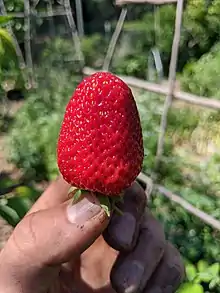
Strawberries are popular and rewarding plants to grow in the domestic environment, be it for consumption or exhibition purposes, almost anywhere in the world. The best time to plant is in late summer or spring. Plant in full sun or dappled shade, and in somewhat sandy soil. The addition of manure and a balanced fertilizer aids strong growth. Alternatively they can be planted in pots or special planters using compost. Fibre mats placed under each plant will protect fruits from touching the ground, and will act as a weed barrier.
Strawberries are tough and will survive many conditions, but during fruit formation, moisture is vital, especially if growing in containers. Moreover, protection must be provided against slugs and snails which attack the ripe fruit. The fruit matures in midsummer (wild varieties can mature earlier) and should be picked when fully ripe — that is, the fruit is a uniform bright red colour. The selection of different varieties can extend the season in both directions.[34] Numerous cultivars have been selected for consumption and for exhibition purposes. The following cultivars have gained the Royal Horticultural Society's Award of Garden Merit:-
Propagation is by runners, which can be pegged down to encourage them to take root,[41] or cut off and placed in a new location. Established plants should be replaced every three years, or sooner if there are signs of disease.
When propagating strawberries, one should avoid using the same soil or containers that were previously used for strawberry cultivation. After cultivating strawberries, rotating to another culture is advisable, because diseases that attack one species might not attack another.[42]
Production
.jpg.webp)
| Strawberry production – 2017 | |
|---|---|
| Country | (millions of tonnes) |
| 3.72 | |
| 1.45 | |
| 0.66 | |
| 0.41 | |
| 0.40 | |
| 0.36 | |
| World | 9.22 |
| Source: FAOSTAT of the United Nations[43] | |
In 2017, world production of strawberries was 9.22 million tonnes, led by China with 40% of the total, and the United States with 16% (table).
Culinary

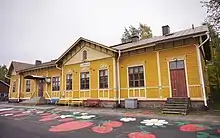
In addition to being consumed fresh, strawberries can be frozen or made into jam or preserves,[45] as well as dried and used in prepared foods, such as cereal bars.[46] Strawberries and strawberry flavorings are a popular addition to dairy products, such as strawberry milk, strawberry ice cream, strawberry milkshakes/smoothies and strawberry yogurts.
In the United Kingdom, "strawberries and cream" is a popular dessert consumed at the Wimbledon tennis tournament.[5] Strawberries and cream is also a staple snack in Mexico, usually available at ice cream parlors. In Sweden, strawberries are a traditional dessert served on St John's Day, also known as Midsummer's Eve. Depending on area, strawberry pie, strawberry rhubarb pie, or strawberry shortcake are also common. In Greece, strawberries may be sprinkled with sugar and then dipped in Metaxa, a brandy, and served as a dessert. In Italy, strawberries are used for various desserts and as a common flavoring for gelato (gelato alla fragola).
Suonenjoki in North Savonia, Finland is small town famous for its strawberries, which is why it is also known as "the Strawberry Town" or "the Strawberry Capital". Many foreigners, mainly from Ukraine and Russia, come to Suonenjoki during the summer to work on strawberry farms. In July, there is a festival in Suonenjoki celebrating the strawberry called Mansikkakarnevaalit ("Strawberry Carnival").[44][47][48]
Nutrients
.jpg.webp) | |
| Nutritional value per 100 g (3.5 oz) | |
|---|---|
| Energy | 136 kJ (33 kcal) |
7.68 g | |
| Sugars | 4.89 g |
| Dietary fiber | 2 g |
0.3 g | |
0.67 g | |
| Vitamins | Quantity %DV† |
| Thiamine (B1) | 2% 0.024 mg |
| Riboflavin (B2) | 2% 0.022 mg |
| Niacin (B3) | 3% 0.386 mg |
| Pantothenic acid (B5) | 3% 0.125 mg |
| Vitamin B6 | 4% 0.047 mg |
| Folate (B9) | 6% 24 μg |
| Choline | 1% 5.7 mg |
| Vitamin C | 71% 58.8 mg |
| Vitamin E | 2% 0.29 mg |
| Vitamin K | 2% 2.2 μg |
| Minerals | Quantity %DV† |
| Calcium | 2% 16 mg |
| Iron | 3% 0.41 mg |
| Magnesium | 4% 13 mg |
| Manganese | 18% 0.386 mg |
| Phosphorus | 3% 24 mg |
| Potassium | 3% 154 mg |
| Sodium | 0% 1 mg |
| Zinc | 1% 0.14 mg |
| Other constituents | Quantity |
| Water | 90.95 g |
| Fluoride | 4.4 µg |
| |
| †Percentages are roughly approximated using US recommendations for adults. Source: USDA FoodData Central | |
One serving (100 g; see Table) of strawberries contains approximately 33 kilocalories, is an excellent source of vitamin C, a good source of manganese, and provides several other vitamins and dietary minerals in lesser amounts.[45][49][50]
Strawberries contain a modest amount of essential unsaturated fatty acids in the achene (seed) oil.[50]
Phytochemicals
Garden strawberries contain the dimeric ellagitannin agrimoniin which is an isomer of sanguiin H-6.[51][52] Other polyphenols present include flavonoids, such as anthocyanins, flavanols, flavonols and phenolic acids, such as hydroxybenzoic acid and hydroxycinnamic acid.[50] Strawberries contain fisetin and possess higher levels of this flavonoid than other fruits.[52][53] Although achenes comprise only about 1% of total fresh weight of a strawberry, they contribute 11% of the total polyphenol in the whole fruit; achene phytochemicals include ellagic acid, ellagic acid glycosides, and ellagitannins.[54]
Color
Pelargonidin-3-glucoside is the major anthocyanin in strawberries and cyanidin-3-glucoside is found in smaller proportions. Although glucose seems to be the most common substituting sugar in strawberry anthocyanins, rutinose, arabinose, and rhamnose conjugates have been found in some strawberry cultivars.[50]
Purple minor pigments consisting of dimeric anthocyanins (flavanol-anthocyanin adducts : catechin(4α→8)pelargonidin 3-O-β-glucopyranoside, epicatechin(4α→8)pelargonidin 3-O-β-glucopyranoside, afzelechin(4α→8)pelargonidin 3-O-β-glucopyranoside and epiafzelechin(4α→8)pelargonidin 3-O-β-glucopyranoside) can also be found in strawberries.[55]
Flavor and fragrance

As strawberry flavor and fragrance are characteristics that may appeal to consumers,[56][57][58] they are used widely in a variety of manufacturing, including foods, beverages, confections, perfumes and cosmetics.[59][60]
Sweetness, fragrance and complex flavor are favorable attributes.[61] In plant breeding and farming, emphasis is placed on sugars, acids, and volatile compounds, which improve the taste and fragrance of a ripe strawberry.[62] Esters, terpenes, and furans are chemical compounds having the strongest relationships to strawberry flavor and fragrance, with a total of 31 out of some 360 volatile compounds significantly correlated to favorable flavor and fragrance.[62][56][57] In breeding strawberries for the commercial market in the United States, the volatile compounds, methyl anthranilate and gamma-decalactone prominent in aromatic wild strawberries, are especially desired for their "sweet and fruity" aroma characteristics.[56][57]
Chemicals present in the fragrance of strawberries include:
- methyl acetate
- (E)-2-hexen-1-ol
- (E)-2-hexenal
- (E)-2-pentenal
- (E,E)-2,4-hexadienal
- (Z)-2-hexenyl acetate
- (Z)-3-hexenyl acetate
- 1-hexanol
- 2-heptanol
- 2-heptanone
- 2-methyl butanoic acid
- 2-methylbutyl acetate
- alpha-terpineol
- amyl acetate
- amyl butyrate
- benzaldehyde
- benzyl acetate
- butyl acetate
- butyl butyrate
- butyl hexanoate
- butyric acid
- octanoic acid
- decyl acetate
- decyl butyrate
- d-limonene
- ethyl 2-methylbutanoate
- ethyl 3-methylbutanoate
- ethyl acetate
- ethyl benzoate
- ethyl butyrate
- ethyl decanoate
- ethyl hexanoate
- ethyl octanoate
- ethyl pentanoate
- ethyl propanoate
- ethyl-2-hexenoate
- α-farnesene
- β-farnesene
- furaneol
- γ-decalactone[56][57]
- γ-dodecalactone
- heptanoic acid
- n-hexanal
- hexanoic acid
- hexyl acetate
- isoamyl acetate
- isoamyl hexanoate
- isopropyl acetate
- isopropyl butanoate
- isopropyl hexanoate
- linalool
- mesifurane
- methyl anthranilate[56][57]
- methyl butyrate
- methyl hexanoate
- methyl isovalerate
- methyl octanoate
- methyl pentanoate
- methyl propanoate
- (E)-nerolidol
- nonanal
- nonanoic acid
- ocimenol
- octyl acetate
- octyl butyrate
- octyl hexanoate
- octyl isovalerate
- propyl butyrate
- propyl hexanoate[63]
Marketing
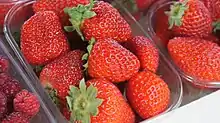
In the United States in 2017, the collective commercial production of strawberries, blueberries, raspberries, and blackberries was a $6 billion industry dominated by the California growing and marketing company Driscoll's.[56] In 2017, strawberries alone were a $3.5 billion market of which 82% was for fresh fruit.[64]
To increase consumer demand in the 21st century, commercial producers of strawberries cultivated them mainly for favorable aroma characteristics similar to those of wild strawberries,[57] in addition to having large size, heart-shape, glossy red exterior, firmness, and slow ripening for long shelf-life favorable to ship by ground transportation from farms to stores nationwide for consumption within two weeks of harvest.[56] In US and Canadian grocery stores, fresh strawberries are typically sold in plastic clamshells, and are among the top fresh produce items in grocery revenues.[56] One marketing analysis identified strawberries and other berries as a source of "happiness" for consumers.[56]
Genetics
Modern strawberries have complex octaploid genetics (8 sets of chromosomes),[65] a trait favoring DNA extractions. Strawberries have been sequenced to display 7,096 genes.[66] Strawberries suffer from severe inbreeding depression, and most cultivars are highly heterozygous. In many entry level Biology classes, strawberries are used to demonstrate the extraction of DNA due to their octoploid structure.
Allergy
Some people experience an anaphylactoid reaction to eating strawberries.[67] The most common form of this reaction is oral allergy syndrome, but symptoms may also mimic hay fever or include dermatitis or hives, and, in severe cases, may cause breathing problems.[68] Proteomic studies indicate that the allergen may be tied to a protein for the red anthocyanin biosynthesis expressed in strawberry ripening, named Fra a1 (Fragaria allergen1).[69] Homologous proteins are found in birch pollen and apple, suggesting that people may develop cross-reactivity to all three species.
White-fruited strawberry cultivars, lacking Fra a1, may be an option for strawberry allergy sufferers. Since they lack a protein necessary for normal ripening by anthocyanin synthesis of red pigments, they do not turn the mature berries of other cultivars red.[69] They ripen but remain white, pale yellow or "golden", appearing like immature berries; this also has the advantage of making them less attractive to birds. A virtually allergen-free cultivar named 'Sofar' is available.[70][71]
See also
- California Strawberry Commission
- Fraise Tagada (strawberry-shaped candy popular in France)
- List of culinary fruits
- List of strawberry cultivars
- List of strawberry dishes
- List of strawberry topics
- Musk strawberry (hautbois strawberry)
- Plant City, Florida (winter strawberry capital of the world)
- Pineberry
- Pomology
- Strawberry cake
- Strawberry sauce
References
- Manganaris GA, Goulas V, Vicente AR, Terry LA (March 2014). "Berry antioxidants: small fruits providing large benefits". Journal of the Science of Food and Agriculture. 94 (5): 825–33. doi:10.1002/jsfa.6432. PMID 24122646.
- "Strawberry, The Maiden With Runners". Botgard.ucla.edu. Archived from the original on 6 July 2010.
- Welsh, Martin. "Strawberries". Nvsuk.org.uk. Archived from the original on 2 August 2008.
- Esau, K. (1977). Anatomy of seed plants. John Wiley and Sons, New York. ISBN 0-471-24520-8.
- "Wimbledon's strawberries and cream has Tudor roots". BBC. 9 June 2015.
- The strawberry; history, breeding, and physiology (PDF). New York Holt Rinehart and Winstonrived. 1966.
- "G6135 Home Fruit Production: Strawberry Cultivars and Their Culture". University of Missouri.
- "Strawberry Seeds". Strawberry Plants. Retrieved 2 August 2016.
- Fletcher, Stevenson Whitcomb (1917) Strawberry Growing, The Macmillan Co., New York, p. 127.
- "Strawberry Plasticulture Offers Sweet Rewards". Ag.ohio-state.edu. 28 June 2002. Retrieved 5 December 2009.
- "Strawberry Production Basics: Matted Row" (PDF). newenglandvfc.org.
- "Pritts Greenhouse Berried Treasures". Hort.cornell.edu.
- "Strawberry Fields Forever". Noble.org.
- Wang SW.; Millner P. (2009). "Effect of Different Cultural Systems on Antioxidant Capacity, Phenolic Content, and Fruit Quality of Strawberries (Fragaria × aranassa Duch.)". Journal of Agricultural and Food Chemistry. 57 (20): 9651–57. doi:10.1021/jf9020575. PMID 20560628.
- Wang SY, Lin HS (November 2003). "Compost as a soil supplement increases the level of antioxidant compounds and oxygen radical absorbance capacity in strawberries". Journal of Agricultural and Food Chemistry. 51 (23): 6844–50. doi:10.1021/jf030196x. PMID 14582984.
- Sagers, Larry A. (15 April 1992). "Proper Cultivation Yields Strawberry Fields Forever". Deseret News. Archived from the original on 20 April 2007.
- "10 facts about Florida strawberries that might surprise you". 7 March 2016. Retrieved 7 June 2018.
- Hokanson, S. C.; Maas, J. L. (2001). Strawberry biotechnology. Plant Breeding Reviews. pp. 139–79. ISBN 978-0-471-41847-4.
- Wilson, D.; Goodall, A.; Reeves, J. (1973). "An improved technique for the germination of strawberry seeds". Euphytica. 22 (2): 362. doi:10.1007/BF00022647. S2CID 26544785.
- Hessayon, D. G. (1996). The House Plant Expert. Sterling Publishing Company, Inc. p. 146. ISBN 9780903505352.
Strawberries grown indoors in strawberry pots.
- "Strawberries in winter? Welcome to franken-season". The Independent. Retrieved 7 June 2018.
- "COUNCIL REGULATION (EC) No 510/2006 'TRUSKAWKA KASZUBSKA' or 'KASZËBSKÔ MALËNA' EC No: PL-PGI-0005-0593-19.03.2007". European Union. 18 April 2009.
- "HS1116/HS370: Nitrogen Fertilization of Strawberry Cultivars: Is Preplant Starter Fertilizer Needed?". Edis.ifas.ufl.edu. 6 August 2007. Retrieved 5 December 2009.
- Bordelon, Bruce. "Growing Strawberries" (PDF). Purdue University.
- "Production Guide for Commercial Strawberries" (PDF). Iowa State University.
- "Commercial Postharvest Handling of Strawberries (Fragaria spp.)". Extension.umn.edu. Archived from the original on 8 July 2013. Retrieved 5 May 2009.
- "Insect Pests of Strawberries and Their Management". Virginiafruit.ento.vt.edu. 3 May 2000. Retrieved 5 December 2009.
- "Radcliffe's IPM World Textbook | CFANS | University of Minnesota". Ipmworld.umn.edu. 20 November 2009. Archived from the original on 26 June 2009. Retrieved 5 December 2009.
- Scipioni, Jade (12 April 2016). "Strawberries are Now the Most Contaminated Produce".
- "Strawberry Diseases". Extension.umn.edu. Archived from the original on 23 March 2009.
- "Strawberry Diseases". Colorado State University. Retrieved 28 March 2018.
- Pleasant, Barbara (2011). "All About Growing Strawberries". Mother Earth News (248): 23–25.
- Davis, Julie Bawden (2009). "Strawberry Success". Organic Gardening. 56 (5): 52–56.
- Klein, Carol (2009). Grow your own fruit. UK: Mitchell Beazley. p. 224. ISBN 978-1-84533-434-5.
- "RHS Plant Selector Fragaria × ananassa 'Cambridge Favourite' (F) AGM / RHS Gardening". Apps.rhs.org.uk.
- "RHS Plant Selector Fragaria × ananassa 'Hapil' (F) AGM / RHS Gardening". Apps.rhs.org.uk.
- "RHS Plant Selector Fragaria × ananassa 'Honeoye' (F) AGM / RHS Gardening". Apps.rhs.org.uk.
- "RHS Plant Selector Fragaria × ananassa 'Pegasus' PBR (F) AGM / RHS Gardening". Apps.rhs.org.uk.
- "RHS Plant Selector Fragaria × ananassa 'Rhapsody' (F) AGM / RHS Gardening". Apps.rhs.org.uk.
- "RHS Plant Selector Fragaria × ananassa 'Symphony' PBR (F) AGM / RHS Gardening". Apps.rhs.org.uk.
- "Propagating Strawberry runners". Youtube. 6 June 2012.
- Lampe, Dianne. "Growing Strawberries". Retrieved 28 April 2013.
- "Strawberry production in 2017, Crops/Regions/World list/Production Quantity (pick lists)". UN Food and Agriculture Organization, Corporate Statistical Database (FAOSTAT). 2018. Retrieved 26 June 2019.
- About Suonenjoki
- Giampieri F, Alvarez-Suarez JM, Mazzoni L, Romandini S, Bompadre S, Diamanti J, Capocasa F, Mezzetti B, Quiles JL, Ferreiro MS, Tulipani S, Battino M (March 2013). "The potential impact of strawberry on human health". Natural Product Research. 27 (4–5): 448–55. doi:10.1080/14786419.2012.706294. PMID 22788743. S2CID 205838719.
- Drummond, Ree (2011). "Strawberry Oatmeal Bars". Food Network. Retrieved 27 March 2013.
- President Niinistö on virtual visits to Suonenjoki and Seinäjoki: Municipalities have shown their ability to respond and adapt
- Visit Suonenjoki
- "Nutrition Facts and Analysis for Strawberries, raw, 100 g; USDA Nutrient Database, SR-21". Nutritiondata.com. Conde Nast. 2014. Retrieved 26 April 2014.
- Giampieri F, Tulipani S, Alvarez-Suarez JM, Quiles JL, Mezzetti B, Battino M (January 2012). "The strawberry: composition, nutritional quality, and impact on human health". Nutrition. 28 (1): 9–19. doi:10.1016/j.nut.2011.08.009. PMID 22153122.
- Lipińska L, Klewicka E, Sójka M (September 2014). "The structure, occurrence and biological activity of ellagitannins: a general review". Acta Scientiarum Polonorum. Technologia Alimentaria. 13 (3): 289–99. doi:10.17306/j.afs.2014.3.7. PMID 24887944.
- Vrhovsek, U.; Guella, G.; Gasperotti, M.; Pojer, E.; Zancato, M.; Mattivi, F. (2012). "Clarifying the Identity of the Main Ellagitannin in the Fruit of the Strawberry, Fragaria vesca and Fragaria ananassa Duch". Journal of Agricultural and Food Chemistry. 60 (10): 2507–16. doi:10.1021/jf2052256. PMID 22339338.
- Khan N, Syed DN, Ahmad N, Mukhtar H (July 2013). "Fisetin: a dietary antioxidant for health promotion". Antioxidants & Redox Signaling. 19 (2): 151–62. doi:10.1089/ars.2012.4901. PMC 3689181. PMID 23121441.
- Aaby, K; Skrede, G; Wrolstad, R. E. (2005). "Phenolic composition and antioxidant activities in flesh and achenes of strawberries (Fragaria ananassa)". Journal of Agricultural and Food Chemistry. 53 (10): 4032–40. doi:10.1021/jf048001o. PMID 15884835.
- Fossen, Torgils; Rayyan, Saleh; Andersen, Øyvind M (2004). "Dimeric anthocyanins from strawberry (Fragaria ananassa) consisting of pelargonidin 3-glucoside covalently linked to four flavan-3-ols". Phytochemistry. 65 (10): 1421–28. doi:10.1016/j.phytochem.2004.05.003. PMID 15231416.
- Dana Goodyear (14 August 2017). "How Driscoll's reinvented the strawberry". The New Yorker. Retrieved 26 June 2019.
- Negri, Alfredo S.; Allegra, Domenico; Simoni, Laura; Rusconi, Fabio; Tonelli, Chiara; Espen, Luca; Galbiati, Massimo (11 February 2015). "Comparative analysis of fruit aroma patterns in the domesticated wild strawberries Profumata di Tortona (F. moschata) and Regina delle Valli (F. vesca)". Frontiers in Plant Science. 6: 56. doi:10.3389/fpls.2015.00056. ISSN 1664-462X. PMC 4324068. PMID 25717332.
- Thompson, J. L.; Lopetcharat, K; Drake, M. A. (2007). "Preferences for commercial strawberry drinkable yogurts among African American, Caucasian, and Hispanic consumers in the United States". Journal of Dairy Science. 90 (11): 4974–87. doi:10.3168/jds.2007-0313. PMID 17954736.
- "How Flavor Chemists Make Your Food So Addictively Good". io9. 8 November 2012. Retrieved 26 April 2014.
- Cassell, D (2014). "2014 Flavor Trends: Yogurt's Fruitful Union". Food Processing. Retrieved 26 April 2014.
- Colquhoun TA, et al. (2012). "Framing the perfect strawberry: An exercise in consumer-assisted selection of fruit crops" (PDF). Journal of Berry Research. 2 (1): 45–61. doi:10.3233/JBR-2011-027. Archived from the original (PDF) on 27 April 2014.
- Schwieterman, M. L.; Colquhoun, T. A.; Jaworski, E. A.; Bartoshuk, L. M.; Gilbert, J. L.; Tieman, D. M.; Odabasi, A. Z.; Moskowitz, H. R.; Folta, K. M.; Klee, H. J.; Sims, C. A.; Whitaker, V. M.; Clark, D. G. (2014). "Strawberry flavor: Diverse chemical compositions, a seasonal influence, and effects on sensory perception". PLOS ONE. 9 (2): e88446. Bibcode:2014PLoSO...988446S. doi:10.1371/journal.pone.0088446. PMC 3921181. PMID 24523895.
- Jouquand, Celine; Chandler, Craig; Plotto, Anne; Goodner, Kevin (2008). "A Sensory and Chemical Analysis of Fresh Strawberries Over Harvest Dates and Seasons Reveals Factors that Affect Eating Quality" (PDF). J. Am. Soc. Hort. Sci. 133 (6): 859–67. doi:10.21273/JASHS.133.6.859.
- "Strawberries". Agricultural Marketing Resource Center, US Department of Agriculture. 1 April 2019. Retrieved 26 June 2019.
- Hirakawa, H; Shirasawa, K; Kosugi, S; Tashiro, K; Nakayama, S; Yamada, M; Kohara, M; Watanabe, A; Kishida, Y; Fujishiro, T; Tsuruoka, H; Minami, C; Sasamoto, S; Kato, M; Nanri, K; Komaki, A; Yanagi, T; Guoxin, Q; Maeda, F; Ishikawa, M; Kuhara, S; Sato, S; Tabata, S; Isobe, S. N. (2014). "Dissection of the octoploid strawberry genome by deep sequencing of the genomes of fragaria species". DNA Research. 21 (2): 169–81. doi:10.1093/dnares/dst049. PMC 3989489. PMID 24282021.
- Bombarely, A; Merchante, C; Csukasi, F; Cruz-Rus, E; Caballero, J. L.; Medina-Escobar, N; Blanco-Portales, R; Botella, M. A.; Muñoz-Blanco, J; Sánchez-Sevilla, J. F.; Valpuesta, V (2010). "Generation and analysis of ESTs from strawberry (Fragaria xananassa) fruits and evaluation of their utility in genetic and molecular studies". BMC Genomics. 11: 503. doi:10.1186/1471-2164-11-503. PMC 2996999. PMID 20849591.
- "Children and food allergies". California Pacific Medical Center. 2013. Retrieved 27 April 2014.
- Patiwael, J. A.; Vullings, L. G.; De Jong, N. W.; Van Toorenenbergen, A. W.; Gerth Van Wijk, R; De Groot, H (2010). "Occupational allergy in strawberry greenhouse workers". International Archives of Allergy and Immunology. 152 (1): 58–65. doi:10.1159/000260084. hdl:1765/28314. PMID 19940506. S2CID 31952236.
- Muñoz, C; Hoffmann, T; Escobar, N. M.; Ludemann, F; Botella, M. A.; Valpuesta, V; Schwab, W (2010). "The strawberry fruit Fra a allergen functions in flavonoid biosynthesis". Molecular Plant. 3 (1): 113–24. doi:10.1093/mp/ssp087. PMID 19969523.
- Hjernø K, Alm R, Canbäck B, Matthiesen R, Trajkovski K, Björk L, Roepstorff P, Emanuelsson C (2006). "Down-regulation of the strawberry Bet v 1-homologous allergen in concert with the flavonoid biosynthesis pathway in colorless strawberry mutant". Proteomics. 6 (5): 1574–87. doi:10.1002/pmic.200500469. PMID 16447153. S2CID 29423198.
- Idea TV GmbH (21 June 2005). "The chemistry of strawberry allergy (includes 'Sofar' reference)". Innovations-report.com. Retrieved 9 March 2013.
External links
| Look up strawberry in Wiktionary, the free dictionary. |
| Wikimedia Commons has media related to |
- Fragaria × ananassa data from GRIN Taxonomy Database
- Thurber, George (1879). . The American Cyclopædia.
- . Encyclopædia Britannica (11th ed.). 1911.
- Demonstration of strawberry growth lifecycle timelapse on YouTube
